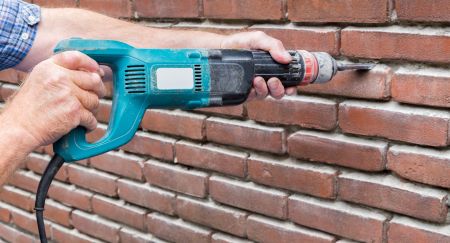Dos and Don’ts for Drilling Masonry
Drilling masonry can be challenging, whether you are working with softer masonry such as clay brick or tougher masonry such as concrete. As this material is much tougher than wood and even many types of metal, you will need to use the right drill, the right drill bits and the right process to make sure that you easily drill into masonry. There are a few mistakes that can result in damaged bits, damaged tools and, in some cases, a high risk of injury in the event of safety protocols not being followed. Understanding the ins and outs of drilling masonry is essential to help you get the job done with minimal hassle.
In this guide, we’re sharing some of the things you will need to do, along with things you certainly should not do when drilling brick, concrete and other types of masonry.
The Basics of Drilling Masonry
From knowing the material you are working with to using the right bits, drilling at the right speed and pressure, and a few other things to keep in mind, here is our list of the dos and don’ts of drilling masonry.
Do…
- Know your material. To choose your bits and drill properly, you first need to have a solid understanding of the material you are drilling. Masonry ranges from softer clay brick that can be drilled fairly easily, to extremely hard reinforced concrete and granite. Each type has properties that determine its strength, porosity and application in construction. Understanding the differences and properties of each type will help you choose the right bit, prevent problems and give you the best results.
- Choose the right bits. Once you have a better understanding of the material you are working with, you can choose your drill bits. There is a variety of masonry drill bits, each made for specific materials and applications. A Multi-Purpose Bit will work on clay brick, but not concrete. A Turbo Concrete Bit will be ideal for clay brick, fire brick, lintel, and most types of concrete. This bit has a rotary hammer-grade centring tip that easily gets through concrete. An Industrial Concrete Bit will get through hardened plaster, brick and concrete, with a profiled tungsten carbide tip. For tougher concrete grades, SDS Bits are the best choice. These bits are designed for use in SDS (Slotted Drive Slot) drills. They can also be used with SDS chucks. Watch our video to find out which SDS bit is best for the masonry you are drilling.
- Drill carefully and smartly. Always go carefully when working with masonry. Make sure that you know what is behind the brick or concrete when drilling into walls or floors so that you prevent accidentally drilling into pipes or rebar by drilling too deeply. Mark the spot you will be drilling, select your speed, and carefully start drilling once you are sure that the drill won’t start to wander. Clear any dust that builds up to prevent flutes from getting clogged with plaster dust. Once you reach the stop point, keep the drill going to remove any final debris remaining on the bit.
- Follow safety protocols. Just like any other material, drilling masonry requires safety protocols. Always make sure that you use eye protection and a dust mask to prevent flying plaster dust and debris. Using the correct drill bit and working slowly will also reduce the risk of safety hazards, as there is less chance of drills slipping or breaking as you work.
Don’t…
- Use the wrong drill. For masonry, you will need to use a hammer drill or an SDS drill that is able to handle heavy-duty drilling. Using a regular cordless drill will end up causing damage to your bits and drill. As this type of drilling involves a lot of friction, it is essential to keep the drill’s RPM as low as possible. Choosing a high-quality drill with multiple settings can prevent overheating and give you more control over speed. A good drill will also help you prolong the lifespan of your tool when working with materials such as brick and concrete.
- Apply too much pressure. A common mistake made when drilling concrete and brick is using too much pressure. This will result in broken bits, overworked drills, safety risks and damaged material. The goal here is to let the drill do the work rather than forcing the drill to work too hard. Using a quality drill will give you more control so that you don’t need to force the drill and apply too much pressure.
- Start working at top speed. Starting at top speed is dangerous, increasing the risk of drills slipping or drill bits breaking. When working with most types of masonry, you will want to work at the lowest speed, without forcing the drill. You can slowly increase the speed once you have gotten your bit through the material. Always make sure that the bit is secure when increasing speed to prevent wandering.
Looking for premium masonry bits? Ruwag offers a selection of drill bits that will give you the best results from drilling masonry.

